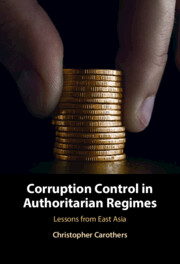Book contents
- Corruption Control in Authoritarian Regimes
- Corruption Control in Authoritarian Regimes
- Copyright page
- Contents
- Figures
- Tables
- Acknowledgments
- 1 Introduction
- 2 Theory and Methodology
- 3 How the Kuomintang Cleaned House in Taiwan
- 4 Corruption Control in Authoritarian South Korea
- 5 The Chinese Communist Party’s War against Corruption, 1921–1990
- 6 Xi Jinping’s Campaign and the End of Political Liberalization
- 7 Anti-corruption Efforts around the Authoritarian World
- 8 Conclusion
- Book part
- Bibliography
- Index
3 - How the Kuomintang Cleaned House in Taiwan
Published online by Cambridge University Press: 31 March 2022
- Corruption Control in Authoritarian Regimes
- Corruption Control in Authoritarian Regimes
- Copyright page
- Contents
- Figures
- Tables
- Acknowledgments
- 1 Introduction
- 2 Theory and Methodology
- 3 How the Kuomintang Cleaned House in Taiwan
- 4 Corruption Control in Authoritarian South Korea
- 5 The Chinese Communist Party’s War against Corruption, 1921–1990
- 6 Xi Jinping’s Campaign and the End of Political Liberalization
- 7 Anti-corruption Efforts around the Authoritarian World
- 8 Conclusion
- Book part
- Bibliography
- Index
Summary
Chapter 3 analyzes how the Kuomintang (KMT) significantly reformed itself, including by bringing corruption under control, after its loss of the Chinese mainland and retreat to Taiwan in 1949. Corruption was rampant in China under KMT rule, despite intermittent efforts at reform, and contributed to the Nationalist regime’s delegitimization and defeat in the Chinese Civil War. Yet, soon after arriving in Taiwan, Chiang Kai-shek led the party in a major restructuring and cleanup, the KMT Reconstruction (1950–52), that curbed organizational dysfunction and corruption and essentially re-founded the regime. I argue that this reform was successful because, while the motivation to reduce corruption had already existed at the top, only after the KMT’s challenging postwar transition did the winning combination of motivation, discretionary power, and state capacity come together. In addition, this chapter analyzes Chiang Ching-kuo’s leadership of the Governmental Rejuvenation (1969–72), which among other things helped reverse a rising trend of bureaucratic corruption. Corruption would only become widespread again in Taiwan after the onset of democratization in the late 1980s.
Keywords
- Type
- Chapter
- Information
- Corruption Control in Authoritarian RegimesLessons from East Asia, pp. 48 - 89Publisher: Cambridge University PressPrint publication year: 2022



